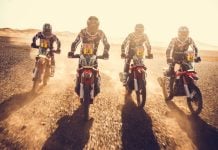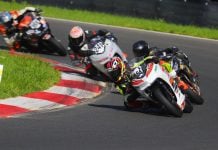By Clive Savacool
Riding motorcycles has always been inherently dangerous. Although safety has improved with better tires, suspension, traction control, and riding gear, the laws of physics still apply when things go wrong. Be it on the track, street, or dirt, fellow riders are often are the first ones to arrive on scene when somebody crashes. And since emergency medical professional may not always be nearby, there are steps rider can take to improve the situation, or at least attempt to prevent further injury until paramedics arrive.
As a career firefighter/paramedic, an AFM racer, and an instructor with a track-day provider, my fellow instructors and recognized the need to develop simple approaches to being more than just bystanders–and actually assist in a emergency medical response.
Even though we developed our approaches for track-day situations, they can also apply to your street or trail riding. The goal is to get the injured rider stabilized, initiate basic life support, and have them ready for transport as soon as possible in order to maximize their overall outcome. In the emergency medicine world, we have a goal called The Golden Hour–getting a trauma victim to definitive care within one hour of the injury. Following these steps before paramedics arrive can shorten the on-scene time for the injured rider, increasing their chance of survival. Keep in mind the physician’s Hippocratic Oath of “first, do no harm,” which is important because many injuries to crash victims actually occur after the initial incident; we want to minimize the chance of further injury.
The first step is to understand and assess the initial scene and plan an approach. There are three priorities when dealing with a downed rider, with the first priority being you. You need to make sure you are safe and that your bike is located in an area where the both of you do not end up becoming bowling pins should another rider come through, grab a handful of brakes, and crash into you. Target-fixation is a real thing, and it is not uncommon for riders to be distracted and crash themselves when approaching an incident. Walk backwards towards the incident if you must, or have a fellow rider watch for traffic, but make sure your safety comes first.
The second priority is making sure your fellow riders and bystanders do not become part of the incident. And the third priority is the downed rider; this may sound callous, but it is there for good reason–to make sure you do not expand the incident, creating more injuries and diverting medical resources from the initial accident.
As you approach the downed rider, you can gain perspective of the potential injuries by looking at their position, the damage to the motorcycle, and the damage to any trackside objects that may have been hit (“furniture,” as some Irish road racers would call it). The rider’s position combined with the collateral damage of the incident will tell you the “Mechanism of Injury,” a medical term to indicate what probable injuries may have occurred. For example, if a rider low-sides and takes a header into the tire wall, the Mechanism of Injury would tell us we could expect head and neck injuries.
As we approach the rider, we want to look at their movements, which can give you an indication of injuries. Are they favoring an arm or a leg, are they moaning, are they moving in a rational manor, or are they disoriented and asking repetitive questions? Most riders, especially newer ones, will lie on the ground for a moment to collect themselves; experienced riders and racers will often jump up and look at their bike to see how damaged it is, even when they have sustained injuries. Many racers have experience with injuries, so the shock factor is not so high following a crash.
If you are an instructor at a track-day event, make eye contact with a cornerworker and let them know what resources you need. This is where it is important to know what hand signals are used at each track so you can communicate the need for a red flag and/or an ambulance, or if there is oil on the track. Having a good relationship with track staff is essential during an unexpected event.
Once we make contact with the injured rider, we typically will not move them. The rare occasions when we will move a rider is if their airway is compromised or if further injury will occur from their current position; but most of the time, we do not move a downed rider.
Next, we follow the basics of Airway, Breathing, and Circulation, or “ABCs.” For our purposes we are just assessing to see how well the rider is managing their airway and how effective their breathing is. There are really only two occasions where we will immediately remove a rider’s helmet–if their airway is blocked in some manner, or if they are vomiting. This is a very delicate procedure, as you can cause further neck injury when removing a helmet if it is not done correctly. That being said, a neck injury is irrelevant if the person dies from not being able to breath. This is one of those exercises you want to practice beforehand. With a quick internet search, you can find a number of online tutorials on how to properly remove an injured rider’s helmet.
The circulation piece for our purposes is basically looking at their skin signs; the big red flag is if they are pale and sweaty. When you are in full leathers lying in the dirt at Buttonwillow Raceway in the middle of August, even a healthy person will be sweaty, but a combination of someone looking pale with profuse sweating can be in indication that the person is going into shock.
The next step is to assess their mental status or “Level of Consciousness;” this is done by asking four basic questions, “What’s your name? What happened? Where are you? What is the date?” If they answer all four questions correctly, we have determined that they are “alert and oriented times four.” This is important to relay to paramedics when they arrive. This line of questioning is used universally among emergency medical personnel, so they will immediately understand what you are telling them.
If you are dealing with a disoriented rider, this can be one of the more challenging scenarios. First, this is an indication of a head injury, which is bad. Secondly, they are rarely cooperative, so you can expect erratic and even combative behavior, repetitive questioning, strange requests, denial of any injury, and most of the time they are going to insist on taking their gear off regardless of what you tell them. We do not want to restrain people in this situation, we want to do our best to calm them down and keep them from injuring themselves further.
Dealing with non-head-injury situations can be easier; our goal with these riders is to simply stabilize their injuries. This is typically done by holding the injured appendage in the position you found it. If you can feel a pulse at the wrist or ankle, great, this tells you that whatever fracture they may have has not severed or blocked an artery. Stabilizing an injury goes the same for head, neck, and back injuries. With this situation we want to hold the person’s helmet in the position we found them, assuming their chin is not pressed against their chest and blocking their airway. Let the injured rider know what you are doing; our goal is to prevent movement of the head that can further injure their spine. Imagine a bowling bowl attached to the end of a broomstick; moving that bowling ball is going to have an immediate effect on that stick, and we want to keep them both from moving. This can be done by kneeling down by the rider’s head and placing your hands on each side of their helmet; this is referred to as “holding c-spine.” Make sure you are comfortable because you are going to be there for a while. Once you hold an injury in place whether it is an arm, leg, or head, you do not let go until you can hand it off to a paramedic.
Bleeding injuries are another challenge. In these situations we want to apply direct pressure to the area to stop the bleeding. If the wound continues to bleed, you can attempt to elevate the appendage above the level of the heart, but this must be done with care to ensure you are not moving the arm or leg in a manner that will injure the rider.
Should it occur, the worst-case scenario is when a rider is in cardiac arrest. We often assume this is from a traumatic injury from a crash, but of the few I have encountered at the racetrack the majority were the result of medical conditions such as a stroke or heart attack. Regardless, if you are trained in CPR, which you really should be for a lot of reasons, you can begin resuscitation efforts. And whether you are trained in CPR or not, it is critical that you get help on the way immediately.
Now that we have done what we can for our fellow rider, we are going to hand them off to the arriving paramedics. The paramedics do not need a long story as to what happened, and they will likely blow you off if they feel you are distracting them from the rider, so your simple goal is to tell them who the rider is, their age, their level of consciousness, extent of their injuries and what you have done. For example, “This is John, he is 36 years old, alert and oriented times three, complaining of left leg pain, it appears his leg is broken at the ankle, we have held his leg in place and kept his head from moving by holding c-spine since he isn’t able to answer all of our questions and we’re worried about a head injury.” The paramedic will thank you and let you know if they want you to keep holding the leg and the head. With this information, the paramedics have a head start on their patient assessment, reducing their on-scene time and you have prevented further injury by stabilizing John. Great job!
Ultimately, a rider critically injured in a motorcycle crash needs definitive care from a surgeon. Your goals are to maximize the rider’s chance of both survival and to minimize injury. Utilizing basic life support skills, you can give riders that chance. I hope this has been helpful. Be safe and always ride with the best gear available!
About the author: Clive Savacool has been an AFM racer and a riding instructor with Carters@theTrack since 2008 on the west coast; he won an AFM Expert-class championship in 2019. Savacool has competed in several professional races including the 2014 Pikes Peak International Hill Climb. Savacool’s experience in the fire service began in 1996 in the San Francisco Bay Area and he recently left the position of Fire Chief for the City of South Lake Tahoe to be CEO of the software company LogRx. For more information on rider first aid, Clive can be contacted at [email protected]







